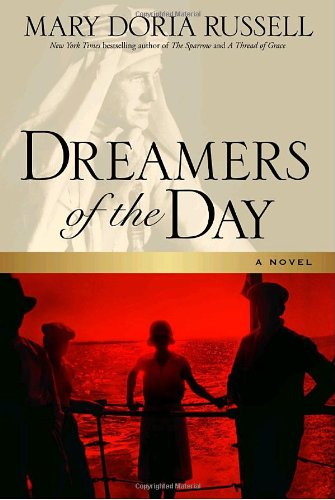Dreamers of the Day
(1)
Mary Doria Russell takes readers from post-World War I Ohio to Egypt and back again in this roman à clef of the creation of the Middle East as we (mostly) know it today. Narrator Agnes Shanklin speaks to us from the afterlife, where she is able to overlay her great tale with the perspective of time. Her story is that of a shy, plain teacher in Cleveland, all alone after the mortality of the Great War and the Great Influenza; she inherits a little money and decides to spend it on a trip to Egypt, following the footsteps of her now-deceased sister’s wedding sojourn. One of her sister’s friends from that time turns out to be none other than T. E. Lawrence (“Neddy”), and once Agnes meets up with him upon her arrival in Cairo the action moves quickly.
Lawrence is attending the famed Cairo Conference of 1921, attempting to mediate the politics- and religion-riddled creation and boundary-setting of countries including Iran, Iraq, and Palestine. Agnes meets the aloof, intellectual Gertrude Bell, befriends a young, imperialist Winston Churchill, and is intrigued by Karl Weilbacher, a German “businessman” who Lawrence repeatedly implies is not in Cairo by chance, and who loves Agnes’s dog Rosie nearly as much as she does. As Agnes’s feelings for Karl deepen, so does her understanding of the issues in the post-Ottoman Empire world, and the reader is privileged to sit in on high-level meetings, experience the heat and crowds of Egypt, and live through incidents revealing the insight and power of Lawrence.
Agnes returns to reality, and the hard times of the 1930s and beyond—about which she moralizes from the afterlife, which is a rather clunky device. However, this is a stimulating read overall, and an excellent fictional supplement to Georgina Howell’s biography, Gertrude Bell: Queen of the Desert, Shaper of Nations.
(2)
‘All men dream, but not equally,’ wrote Lawrence of Arabia. ‘Those who dream at night awaken to find it vanity, but the dreamers of the day are dangerous men …’ The influenza pandemic of 1919 leaves Agnes Shanklin the only survivor of her family, and beneficiary of three legacies. A teacher in small-town Ohio, she takes a Cooks’ tour two years later to Egypt and the Holy Land, arriving in Cairo with her dachshund Rosie as the Peace Conference is getting under way. Here are young Winston Churchill, T.E. Lawrence, Lady Gertrude Bell, inventing the nations of Iraq, Syria, Lebanon, and Jordan, the reverberations of their decisions still felt throughout the Middle East today. Entertained and escorted by both Churchill and Lawrence, and by Karl Weilbacher, a German spy who has shadowed Lawrence since his days as an archaeologist, Agnes is drawn into geopolitical intrigue and towards a personal awakening.
Told entirely in the first person from Agnes’s viewpoint, looking back on her life in a chatty, confiding manner: ‘Well, my goodness,’ and ‘I’m getting to that,’ and even asking what the reader would have done – and in a bizarre twist in the final chapter, apparently from beyond the grave – the book skilfully blends real and fictional protagonists: the Churchills, Lawrence and Bell are all convincingly drawn. Agnes’ visit to Jerusalem reads like a travel diary, but the details are authentic and add richness and colour to what is ultimately a sad life. I felt rather sorry for her.










